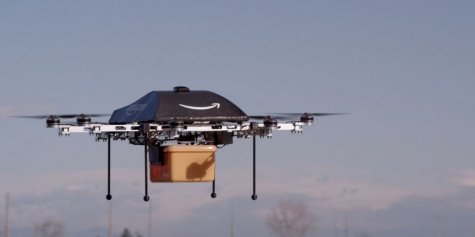Drones: delivering more than just warfare
December 17, 2014
People tend to imagine drones as huge, metal, pilotless killing machines that circle the skies, ready to fire bullets at anything that moves, but the idea that drones only serve to kill is a complete misconception
Technically speaking, a drone is not a weapon; drones are simply remote-controlled, pilotless aircraft. In addition, they are not necessarily the giant metal plane-like structures that appear on the news; they come in many sizes, some small enough to fit in the palm of the hand. This definition of drones, machines that are capable of traveling from one location to another through the air, reveals that the possibilities of this emerging technology extends far beyond the needs of the military.
One major use of drones that is currently being explored is delivery by drone. Small flying drones could be used to deliver groceries or packages to those who order these commodities online. Drones would be more efficient that traditional delivery by being able to utilize the open skies to bypass traffic. In addition, each drone in a team of drones could deliver packages to their respective houses directly from a warehouse, as opposed to a mailman having to carry all his packages in a truck and follow a long delivery path to reach all the package destinations.
This sci-fi form of delivery is already on the verge of becoming a reality in certain parts of the globe. On May 11 of this year, the first pizza was delivered by drone in Mumbai, India, a city famous for its Italian food. In addition, the Chinese delivery company SF Express was spotted testing drone delivery of online orders in Dongguan, China.
In the United States, Amazon is currently on the verge of putting this technology into large-scale use. Amazon’s CEO Jeff Bezos revealed his plan for “Amazon Prime Air,” a service that would allow packages ordered from Amazon to be delivered within 30 minutes by use of drones (for Amazon Prime customers only, of course). Small delivery drones would be able to deliver packages that are five pounds or lighter directly from an Amazon warehouse to the customer, drastically reducing delivery times. The only obstacle facing the plan is the Federal Aviation Administration (FAA), which has yet to grant permission to Amazon to start using drones commercially. According to Amazon’s website, if the FAA grants the company permission, Amazon Prime Air will begin shipping as early as 2015.

While the benefits of drones in civilian life clearly have substantial benefits, but the issue of privacy creates problems surrounding the widespread introduction of drones into everyday life.
Small, remote-controlled drones can be equipped with cameras that allow the user of the drone to capture photo and video remotely by flying to high altitudes and to distances far away from the user. These “mobile cameras” of sorts can serve many beneficial uses, such as allowing photographers to capture stunning views of wildlife without disturbing the environment or facilitating the broadcast of a sporting event.
Like many other forms of modern technology, however, the paparazzi have found a way to abuse this good-intentioned device. Paparazzi have used small drones equipped with cameras to capture images and footage of celebrities in their homes and in other private locations and situations. Certain celebrities, including actress Halle Berry and model Kendra Wilkinson, have spoken out against this use of drones, saying that it compromises the privacy of the celebrity community.
In response, on September 30, Governor Jerry Brown signed a law that intends to prevent the paparazzi form using drones to spy on celebrities. However, there is question around the effectiveness of this law because these drones are often very small and inconspicuous, making the law hard to enforce. Even if a drone is spotted, it will be hard to track a drone back to a person because they are controlled remotely; the owner of a drone may be miles away from the drone itself, safely out of the proximity of his or her “second pair of eyes.”
Regardless of the pros and cons, drones will most likely continue to become more prevalent in regular civilian life as prices of drones continue to drop and the technology becomes more understood by the general public. As the usefulness and efficiency of drones becomes more widely understood and put to work, you might find a drone whizzing over your head in the not-so-distant future.












